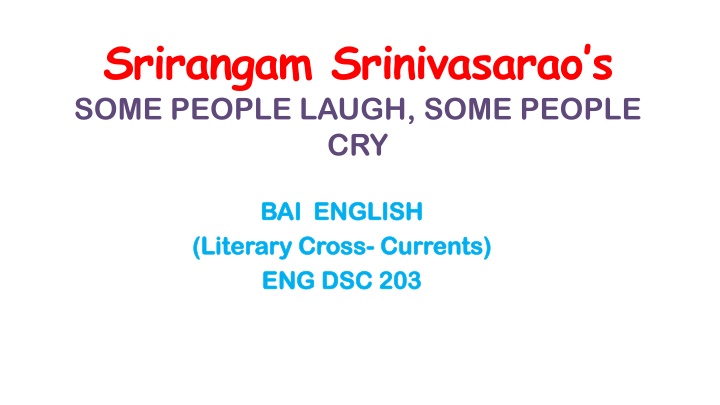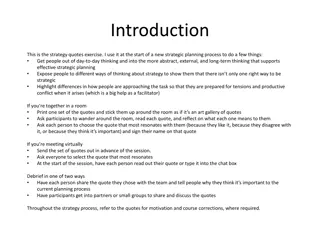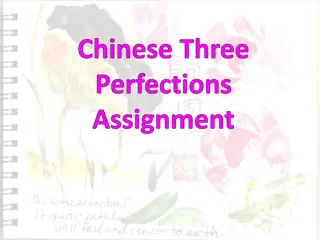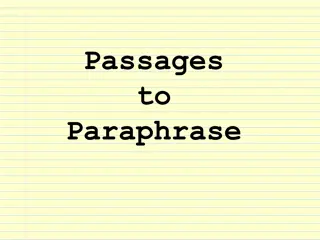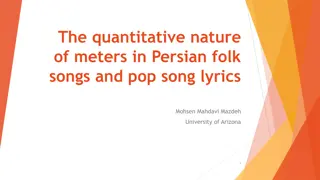Sri Sri's Thought-Provoking Poetry: An Overview
Sri Sri, popularly known as Srirangam Srinivasarao, was a Telugu poet who revolutionized modern Telugu poetry by addressing contemporary issues. His poem "Forward March" signifies a call for a new classless society, while "Some People Laugh, Some People Cry" reflects his surrealistic vision of urban life. Sri Sri's works continue to influence generations of poets, marking a new epoch in Telugu literature.
Download Presentation

Please find below an Image/Link to download the presentation.
The content on the website is provided AS IS for your information and personal use only. It may not be sold, licensed, or shared on other websites without obtaining consent from the author.If you encounter any issues during the download, it is possible that the publisher has removed the file from their server.
You are allowed to download the files provided on this website for personal or commercial use, subject to the condition that they are used lawfully. All files are the property of their respective owners.
The content on the website is provided AS IS for your information and personal use only. It may not be sold, licensed, or shared on other websites without obtaining consent from the author.
E N D
Presentation Transcript
Srirangam Srinivasaraos SOME PEOPLE LAUGH, SOME PEOPLE CRY BAI ENGLISH BAI ENGLISH (Literary Cross (Literary Cross- - Currents) ENG DSC 203 ENG DSC 203 Currents)
Srirangam Srinivasarao (30 April 1910 15 June 1983) Popularly known as Sri Sri, Srirangam Srinivasarao was a Telugu poet and lyricist. He was a member of PEN INDIA, Sahitya.
ABOUT THE POET Popularly known as Sri Sri, Srinivasa Rao was a Telugu poet and lyricist. He was a member of PEN INDIA, Sahitya Academy, Vice-President of the South Indian Film Writers Association, Madras and President of the revolutionary writers association of Andhra. Srirangam Srinivasa Rao was the first true modern Telugu poet to write about contemporary issues that affected day-to day life of a common man in a style and metre which were not used in classical Telugu poetry. He wrote visionary poems in a style and metre not used before in Telugu classical poetry. He moved poetry forward from traditional mythological themes to reflect more contemporary issues.
FORWARD MARCH Mahaprasthanam' was one of the poems in Sri Sri's second collection of poems with the same title, published in 1950. It's translated version, 'Forward March' appeared in the collection 'Three Cheers for Man' in 1956. the poem in translation was later published in Sri Sri Miscellany in 1970. The poem was a product of diverse influences ranging from Adi Shankaracharya to Wilfred Owen. The poem started a new epoch in Telegu literature and influenced a whole generation of poets. It employs a new idiom to express a collective experience.
THEME AND SIGNIFICANCE Sri Sri's poem, 'Forward March' sounds a bugle for a new classless society. It calls upon the youth to start a revolution for
SOME PEOPLE LAUGH, SOME PEOPLE CRY 'Some People Laugh, Some People Cry' is a prose poem expressing the poets surrealistic vision of the world around him. This chaotic world is populated by suicidal philanthropists, one eyed pups and unfinished sagas. In a way' the poem is a picture of modern urban life where everybody is an island in himself and nobody bothers to see what's happening around him.
SUMMARY The poem 'Some people laugh, Some people cry' is a series of snapshots of figures of oppressive loneliness. In the first picture, a man walking on the bride gives the change from his pocket to a beggar. Then he gives away his wristwatch to a nurse who happens to pass that way. Next he throws his coat into the river and following the coat drowns himself in the water. The poet thus has presented a surrealistic image of the incoherent urban life represented by the suicidal philanthropist, the beggar and the nurse. All the three have been brought together to demonstrate the absurdity of human actions due to frustration. The man who commits suicide is perhaps a capitalist who has found no meaning or purpose in life. The next pictuure is an image of a capitalist who knows all the tricks and tactics of his trade and has made a lot f money. Money grows up like plants which yield golden eggs in the safe lockers of the banks, where the eggs lies stuffed up. But behind all this money tears are clearly visible. As the yolk comes out when an egg is broken, so the tears are seen when we peep into the heart of this man who is frustrated and broken.
The sixth picture takes the scene to a man who offers anarchy for sale. The implication is that he advocates criminality, lawlessness, theft, dacoit, etc.. as source of getting money. With his long arms he is searching for something with which to convert young men to anarchists. The giant lemon he eats once a day is usually found in lakes of blood in young hearts. Anarchy feeds itself on violence and bloodshed. It is terrible image of the world rotting in chaos and the anarchist taints the blood of young people with his oratory to beguile them for anarchy. The next scene shifts to a musician who is singing Raga khamboji and playing on a lute. He has got perfection with different ragas whose music has the power to heighten people's fancy which establishes a harmony in nature and offers a marriage to beautiful girl. Then there is the picture of a poet applying traditional kaajal in his eyes and kumkum on his cheeks. The poet presents himself in a trance like state but then his image transforms into a cryptographer deciphering the secret codes and working for the air force. He is said to be directly responsible for the fall of prices in the market. It is rather a confusing picture of the creative artists like musicians and poets. The poet perhaps implies that art, which aroused some hope of some bright spot in human existence, has turned into business filling life with frustration and hopelessness. The eight picture brings us to the sight of a seemingly holy man with a string of rudraksha beads around his neck is meditating. He is hypocrite and his religious knowledge doesn't go beyond coconuts people break in front of him to obtain blessing. It is a common feature of Indian society steeped in ignorance and superstition which deifies and hypocrite posing as spiritual leader.
The next short scene pertains to a man who loves only one woman and she dies. The poet then makes a reference to the world of films, Bollywood where this idea is portrayed in film after film. The same theme repeated in every film with slight variations becomes boring and frustrating. The idea of permanent love is just an ironic comment of the emotion of love as it is not to be found in real life situations. The tenth picture is of a man who gets hanged for a crime he has not committed but refuses to say that he is being unjustly executed. The scene brings forth the power of an anarchical state where and individual pitted against the state is powerless to protest against injustice and is hanged. No one but a loyal dog of his remembers him and weeps for him. The scene is a comment on the legal system and procedure, the unjust judgment of the courts and the poor people who are made scope-goats because they are unable to get costly defense Next is the picture of a society in its decay where a man prospers by making false promises and pompous speeches, while another one dies of drinking too much due to frustration. A boy takes a coin from his maternal aunt and buys a kite another boy snatches it away from him. The picture thus, is a society where the weak and defenseless are being exploited by the clever and powerful. The last picture of the poem presents frustration, emptiness and futility of life depicted in mundane images of a man running away and of another man struggling with life and killing himself. A third man get married, fourth one sleeps, fifth dozes, while the sixth one talks endlessly to kill time. Then there is one man whose crying makes people laugh, while another man's laugh makes them cry. Being asked if there is any end to these frustrating absurdist, the poet replies that there is no end to these.
